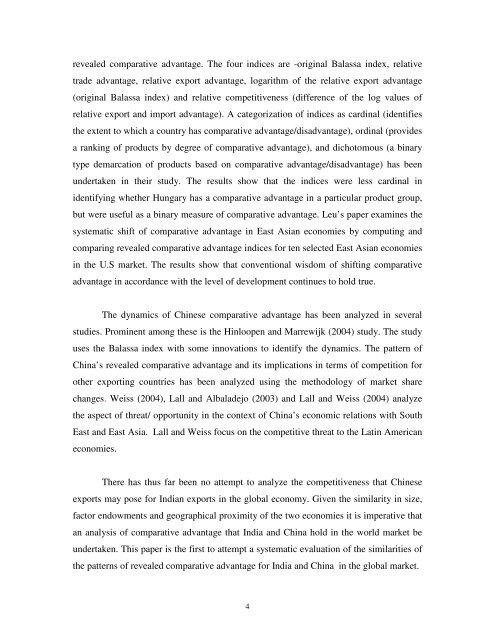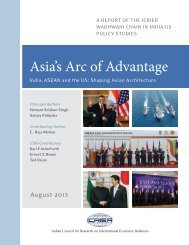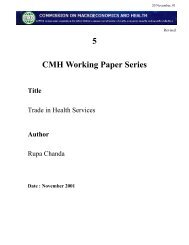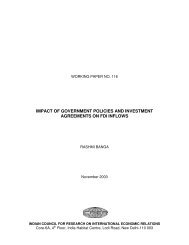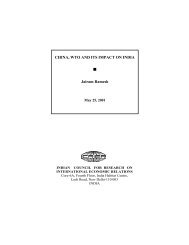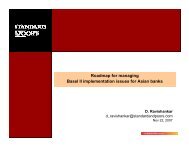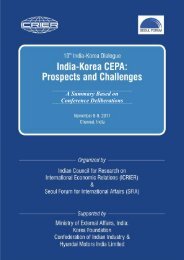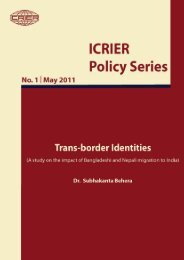an analysis for india and china - icrier
an analysis for india and china - icrier
an analysis for india and china - icrier
Create successful ePaper yourself
Turn your PDF publications into a flip-book with our unique Google optimized e-Paper software.
evealed comparative adv<strong>an</strong>tage. The four indices are -original Balassa index, relative<br />
trade adv<strong>an</strong>tage, relative export adv<strong>an</strong>tage, logarithm of the relative export adv<strong>an</strong>tage<br />
(original Balassa index) <strong>an</strong>d relative competitiveness (difference of the log values of<br />
relative export <strong>an</strong>d import adv<strong>an</strong>tage). A categorization of indices as cardinal (identifies<br />
the extent to which a country has comparative adv<strong>an</strong>tage/disadv<strong>an</strong>tage), ordinal (provides<br />
a r<strong>an</strong>king of products by degree of comparative adv<strong>an</strong>tage), <strong>an</strong>d dichotomous (a binary<br />
type demarcation of products based on comparative adv<strong>an</strong>tage/disadv<strong>an</strong>tage) has been<br />
undertaken in their study. The results show that the indices were less cardinal in<br />
identifying whether Hungary has a comparative adv<strong>an</strong>tage in a particular product group,<br />
but were useful as a binary measure of comparative adv<strong>an</strong>tage. Leu’s paper examines the<br />
systematic shift of comparative adv<strong>an</strong>tage in East Asi<strong>an</strong> economies by computing <strong>an</strong>d<br />
comparing revealed comparative adv<strong>an</strong>tage indices <strong>for</strong> ten selected East Asi<strong>an</strong> economies<br />
in the U.S market. The results show that conventional wisdom of shifting comparative<br />
adv<strong>an</strong>tage in accord<strong>an</strong>ce with the level of development continues to hold true.<br />
The dynamics of Chinese comparative adv<strong>an</strong>tage has been <strong>an</strong>alyzed in several<br />
studies. Prominent among these is the Hinloopen <strong>an</strong>d Marrewijk (2004) study. The study<br />
uses the Balassa index with some innovations to identify the dynamics. The pattern of<br />
China’s revealed comparative adv<strong>an</strong>tage <strong>an</strong>d its implications in terms of competition <strong>for</strong><br />
other exporting countries has been <strong>an</strong>alyzed using the methodology of market share<br />
ch<strong>an</strong>ges. Weiss (2004), Lall <strong>an</strong>d Albaladejo (2003) <strong>an</strong>d Lall <strong>an</strong>d Weiss (2004) <strong>an</strong>alyze<br />
the aspect of threat/ opportunity in the context of China’s economic relations with South<br />
East <strong>an</strong>d East Asia. Lall <strong>an</strong>d Weiss focus on the competitive threat to the Latin Americ<strong>an</strong><br />
economies.<br />
There has thus far been no attempt to <strong>an</strong>alyze the competitiveness that Chinese<br />
exports may pose <strong>for</strong> Indi<strong>an</strong> exports in the global economy. Given the similarity in size,<br />
factor endowments <strong>an</strong>d geographical proximity of the two economies it is imperative that<br />
<strong>an</strong> <strong>an</strong>alysis of comparative adv<strong>an</strong>tage that India <strong>an</strong>d China hold in the world market be<br />
undertaken. This paper is the first to attempt a systematic evaluation of the similarities of<br />
the patterns of revealed comparative adv<strong>an</strong>tage <strong>for</strong> India <strong>an</strong>d China in the global market.<br />
4


